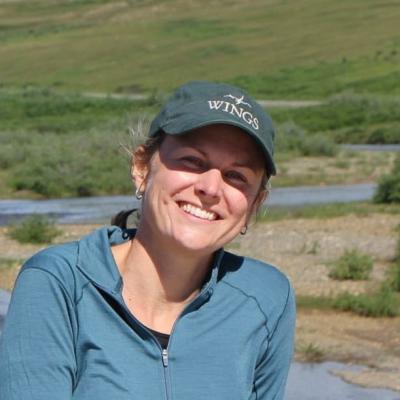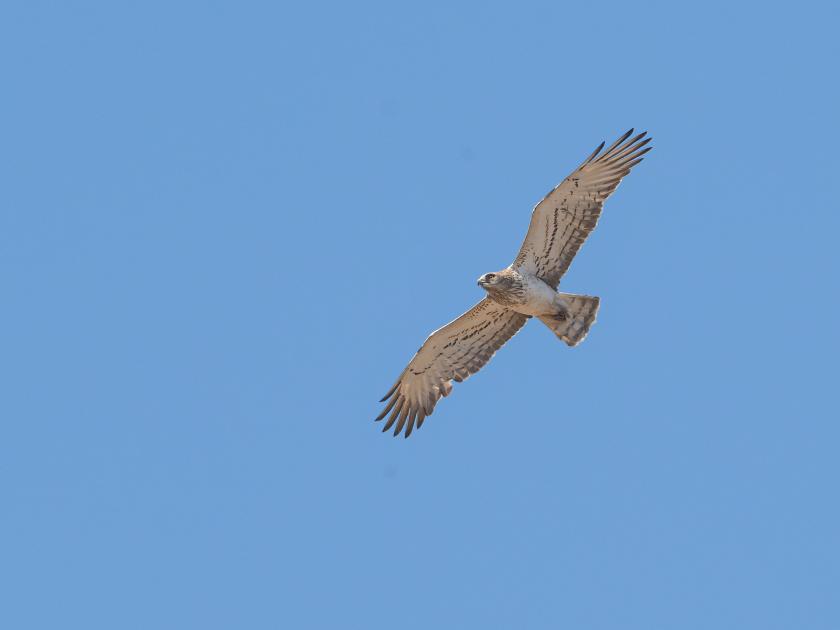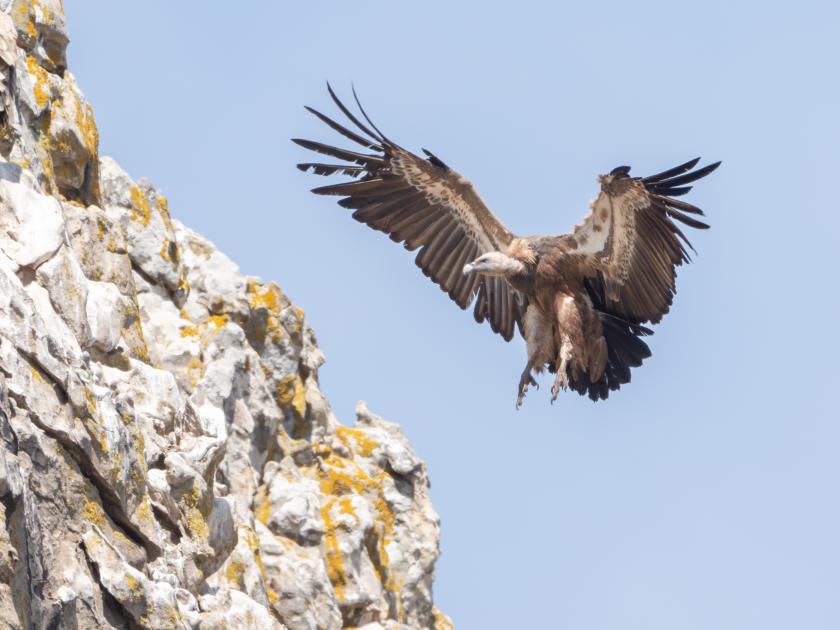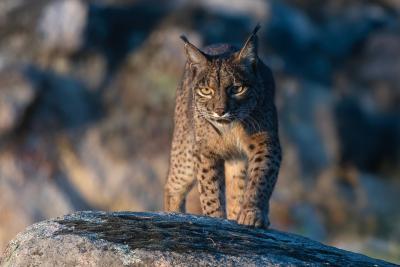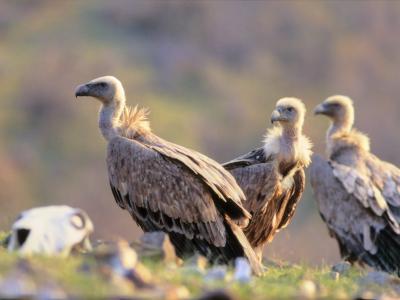Spain in Autumn
-
Sep 7-17, 2026
Oli Reville and a local leader
Tour Price to be Determined
Tour Price to be Determined
This exciting tour focuses on the country’s most southern region, Andalusia, an area of great contrast, with vast plains, towering mountains, stunning coastlines, and rolling countryside with attractive pueblos blancos (white towns) dotting the landscape. We’ll explore these habitats and visit the Strait of Gibraltar, Western Europe’s primary migration flyway looking for White-headed Duck, Great Bustard, and Northern Bald Ibis among many others.
We’ll experience the spectacle of migration with some 25 species of shorebird, including the striking Collared Pratincole, and 20 species of raptor, including Spanish Imperial Eagle.
We’ll also offer a fantastic cetacean-watching trip off the coast of Cádiz province, with a good mix of seabirds and stunning views of Morocco across the Strait of Gibraltar as a bonus.
This tour is perfect for travelers looking to enjoy the wonderful weather, culture and food of Southern Spain and the impressive spectacle of the European fall migration. Typically, we can expect to encounter 170-190 bird species along the way.
Day 1: The tour begins this evening in Seville with a welcome meal at our hotel. Night in Seville.
Day 2: Our first day of birding will begin by exploring the vast expanses of Brazo del Este. This important wetland area along the east bank of the Guadalquivir River is a birding paradise with a huge array of species on offer, and we’ll make our first efforts with species such as Marbled and White-headed Ducks, Red-knobbed Coot, and Spanish Imperial Eagle. Among the many shorebirds we’ll look particularly for Collared Pratincole, and we’ll scan the reedbeds for migrating warblers such as Eurasian Reed Warbler and Melodious Warbler.
After lunch we will explore the coastal saltpans and neighboring habitats south of Brazo del Este. Species such as Marbled Duck, White-headed Duck, Western Swamphen, Temminck’s Stint, Common Kingfisher, Common Raven, Crested Lark, and Red-rumped Swallow are all possible here.
Finally, we will head to the marshlands bordering the Guadalquivir where we can find Greater Flamingo, Slender-billed Gull, Caspian Tern, Eurasian Spoonbill, Osprey, Western Marsh Harrier, and the often elusive Mediterranean Short-toed Lark. Night in Sanlucar de Barrameda.
Days 3-7: We’ll spend the next five nights along the Strait of Gibraltar as we explore this famous birding area. Before we make our journey to the Strait, we'll visit mainland Europe’s only breeding colony of Little Swift, in the town of Chipiona. While in the area we'll visit coastal sites for a wide range of shorebirds, terns, and gulls including Audouin’s Gull, a stunning species which is globally threatened.
Once we reach the Strait, the array of available species during these days will be large. If the winds are favorable, we should get to witness impressive raptor migration as well as large numbers of White Storks circling over the coast before migrating across to Africa. We’ll also search for migratory passerines, shorebirds, and seabirds and visit a range of habitats around the Strait which can hold a range of interesting resident and migrant species.
Our itinerary is flexible in order to take any birding opportunity that might arise based on the wind and migration patterns, but some highlights of our time here will include a visit to a Eurasian Griffon colony, where recent sightings of Rüppell’s Vulture have added an increased interest. We’ll also search out the endangered Northern Bald Ibis which now breed in the area.
During our time around Tarifa we’ll take a cetacean-focused boat trip out to where the Atlantic Ocean meets the Mediterranean Sea which will give us stunning views of the Spanish and Moroccan coasts. Nights in Tarifa.
Days 8-9: We’ll leave the coast behind as we head for the beautiful Sierra Grazalema mountains and the surrounding area. Resident mountain species like Black Wheatear, Blue Rock Thrush, European Crested Tit, Bonelli’s Eagle, and Iberian Grey Shrike will be the focus, with a range of other resident and migratory species greeting us at every turn. With luck we may also come across the magnificent Iberian Ibex, which is endemic to the Iberian Peninsula. This area is one of Andalusia’s finest for scenery and the pueblos blancos, a series of whitewashed towns and villages dotted across the mountain slopes and valleys will make a fascinating backdrop to our birding here. Nights in Ronda.
Day 10: We’ll leave the mountains behind and drop down into the plains east of Seville. This area of agriculture and grasslands holds some special birds, with Great and Little Bustards being our primary targets. Migrating raptors use these fields to hunt en route to the coast, so we’ll keep an eye out for Egyptian Vulture, Montagu’s Harrier, Black Kite, and eagles such as Booted and Short-toed Snake. The open habitat also appeals to iconic Spanish species like European Bee-eater, Mediterranean Short-toed Lark, and Calandra Lark.
While in the area we’ll also visit Fuente de Piedra, which can hold water despite the late summer heat. If so, waterbirds and shorebirds will be numerous with Purple Heron, Greater Flamingo, Eurasian Stone-Curlew, Ferruginous Duck, and Red-crested Pochard all possible. We’ll also search for passerines such as Western Bonelli’s, Melodious and Sardinian Warblers, Eurasian Hoopoe, Zitting Cisticola, and Black Redstart. Night in Antequera.
Day 11: On our last early morning we’ll head to suitable sites near Osuna for another chance at birds we may have missed on Day 10. If time allows, our final stop will be to look for the striking Iberian Magpie outside Seville. We'll then head to the airport where our tour concludes at noon. Departure from SVQ.
Note: The information presented below has been extracted from our formal General Information for this tour. It covers topics we feel potential registrants may wish to consider before booking space. The complete General Information for this tour will be sent to all tour registrants and of course supplemental information, if needed, is available from the WINGS office.
ENTERING SPAIN: U.S. citizens will need a passport valid for at least three months beyond your scheduled date of departure from the country, and with at least one blank page for an entry stamp. A visa is not required for stays of fewer than 90 days. Citizens of other nations should contact the nearest Spanish Consulate for entry requirements.
COUNTRY INFORMATION: You can review the U.S. Department of State Country Specific Travel Information at https://travel.state.gov/content/travel/en/international-travel/International-Travel-Country-Information-Pages/Spain.html
TOUR START: The tour starts at our first night’s hotel, AC Sevilla Forum by Marriott. The hotel does not offer shuttle service, but is easily accessible by taxi. It’s about a 10-minute ride costing approximately 30 EUR. We plan an introductory meeting and dinner on the evening of Day 1. We can assist with booking pre- or post-tour extra nights at this hotel (following tour confirmation).
PACE OF THE TOUR: This is a fairly relaxed tour: leisurely walking, only occasionally over moderately rough or steep terrain, is the only physical requirement. Despite covering a relatively large area of Spain we do not anticipate any especially long drives – the longest stretch being about 2 hours. Due to the location of our hotels, and sunrise not being until 8am, we will have breakfast before heading out for the day. Lunch is in a café en route to our next birding location. Smaller group sized may enable us to have picnic lunches in suitable birding locations. There are normally daily morning stops for tea, coffee or a cold drink. We usually return to the hotel at around 7:30 p.m. Breakfasts and dinners are usually taken late in Spain with several of our hotels not serving dinner before 8:30 p.m.
Virtually all the walking is fairly easy and on good paths or tracks. Most of the birdwatching is done within a short distance of our vehicle. There will be regular opportunities for bathroom breaks on this tour with birding usually commencing straight after. Please be aware that in some areas we may be away from available bathrooms for at least a couple of hours.
We will also be undertaking a cetacean-watching trip on this tour so please bear this in mind. If you suffer with sea sickness, please ensure you have the correct medication with you.
HEALTH: The Centers for Disease Control and Prevention (CDC) recommends that all travelers be up to date on routine vaccinations. These include measles-mumps-rubella (MMR) vaccine, diphtheria-tetanus-pertussis vaccine, varicella (chickenpox) vaccine, polio vaccine, and your yearly flu shot.
They further recommend that most travelers have protection against Hepatitis A.
The most current information about travelers’ health recommendations can be found on the CDC’s Travel Health website at https://wwwnc.cdc.gov/travel/destinations/traveler/none/spain.
Smoking: Smoking and vaping is prohibited in the vehicles or when the group is gathered for meals, checklists, etc. If you are sharing a room with a nonsmoker, please do not smoke in the room. If you smoke in the field, do so well away and downwind from the group. If any location where the group is gathered has a stricter policy than the WINGS policy, that stricter policy will prevail.
Miscellaneous: Day flying mosquitoes can be a problem in some areas, so bring an insect repellent. We recommend using insect repellents with a high concentration of DEET.
Tap water is safe to drink. However, we recommend sticking to bottled water if you are prone to a sensitive stomach when drinking tap water in new countries.
CLIMATE: Temperatures on this tour will vary due to the range of habitats we will cover. Low lying inland areas could see temperatures reach up to 95°F (35°C), however we will not be in these areas for much of the tour. Most of the tour will see us visit coastal areas where temperatures of 82°F (29°C) will be more typical. However, strong winds can occur in these coastal areas which will reduce the temperature by a few degrees, despite the fierceness of the sun in early September. Sunshine should be plentiful and retains high intensity in early September so please remember sunblock for this tour. September is typically a dry month in this part of Spain, and we shouldn’t see any significant rainfall. For the pelagic trips a warmer layer is recommended as while the sun will be intense, the wind can be quite cooling.
ACCOMMODATION: The tour stays at a number of hotels all of which have private bathroom facilities. Some have balconies and many have good views of the Spanish countryside with birdwatching right on the doorstep.
FOOD: Breakfasts are quite varied but with the usual staple items e.g. coffee, tea, juice and toast or pastries found at most of the hotels. The further inland we travel the more local delicacies such as cheese and smoked meats appear on the breakfast menu. Lunch will often be a picnic, (provided by our guide/s), which will include a selection of fresh bread, fruit and vegetables, cheese, cold meats, olives, etc. Alternatively we have tapas-style lunches at local bars. Evening meals are taken late in Spain (usually 8.30-9.00pm) which allows us to make the most of the daylight hours for birding.
Drinks: Bottled water and/or a soft drink, beer or wine is provided at lunch and dinner, as is coffee or tea. All other drinks or ‘personal’ drinking water for use in your room etc. is the responsibility of the individual. We will keep bottled water on the minibus for use during the day.
TRANSPORTATION: Transportation will be by minibus driven by the leader(s). The leader will arrange a seating rotation. Participants should be willing and able to ride in any seat in tour vehicles.
2025 Narrative
In Brief
Our 2025 Spain in Autumn tour gave us 11 days of incredible birding in southern Andalucia. With glorious, if slightly hot, weather we achieved a lofty total of 179 species. The tour highlights included 18 species of birds of prey, including rare species like Spanish Eagle, Egyptian Vulture, and Rüppell’s Griffon plus witnessing the marvel of raptor migration. We also enjoyed species which make this region so special, including Marbled Duck, Ferruginous Duck, White-headed Duck, Great Bustard, Little Bustard, Little Swift, Red-knobbed Coot, Audouin’s Gull, Northern Bald Ibis, Black-winged Kite, Montagu’s Harrier, European Bee-eater, Iberian Grey Shrike, Iberian Magpie, Calandra Lark, Iberian Chiffchaff, Blue Rock Thrush, Black Wheatear, and Ortolan Bunting.
Accompanied by amazing food, beautiful scenery, and fabulous company this really was a tour to remember.
In Detail
Day 1 – 7th September 2025
Our exciting tour of southern Spain began in Seville with our welcome meeting and first evening meal of the tour.
Day 2 – 8th September 2025
Our first stop was the farmland area south of the city known as Los Palacios. Our main target here was the recently colonising Laughing Dove. Despite giving us the runaround we enjoyed flight views of this recent coloniser in Spain, the first time this species has been recorded on this tour. Other species found here included European Turtle Dove, Pallid Swift, Eurasian Hoopoe, Common Kingfisher, Common Reed Warbler, European Red-rumped Swallow, and Spotted Flycatcher.
Our next stop was the vast wetland area known as Brazo del Este. The temperature began to rise but fortunately so did the exciting species with the group enjoying thousands of Glossy Ibis plus smaller numbers of Marbled Duck, Black-winged Stilt, Northern Lapwing, over 1000 Lesser Black-backed Gull, Whiskered Tern, Greater Flamingo, Eurasian Spoonbill, Purple Heron, Booted Eagle, European Bee-eater, and some striking, albeit introduced, Yellow-crowned Bishop. Perhaps the most unexpected species found here were a female Northern Pintail and a stunning White-winged Tern.
To escape the main heat of the day we headed for lunch at a local restaurant but continuing with birding in the afternoon heat. Our final stop of the day was a visit to farmland with our main target, Rufous-tailed Scrub-Robin. Despite our best efforts this increasingly declining species eluded us, but we enjoyed nice views of Eurasian Griffon, Booted Eagle, Willow Warbler, and Northern Wheatear. With Spanish Sparrow and an elusive Common Redstart also being present.
Day 3 – 9th September 2025
Our day began with a visit to Chipiona and Europe’s only breeding colony of Little Swift, and we enjoyed fabulous views as they swept around us in the early morning light. The next stop was a nearby beach which provided us with some new species for the tour. These included Black-bellied Plover, Sanderling, Slender-billed Gull, Caspian Tern, and Sandwich Tern.
We then turned our attention to the vast salt pans at Bonanza. The heat haze made viewing tricky, but we still managed to find Common Shelduck, Kentish Plover, Whimbrel, Black-tailed Godwit, Curlew Sandpiper, Little Stint, Osprey, and European Stonechat. After lunch we headed for some local lagoons where we were able to enjoy White-headed Duck, Eared Grebe, Little Bittern, Squacco Heron, and Common Kingfisher, amongst others.
Our final visit in the area would be to Costa Ballena, a very sculptured but productive park. Here we were able to find our main target, Red-knobbed Coot. Other interesting birds here included a group of 18 Common Greenshank, Iberian Chiffchaff, European Pied Flycatcher, Spotted Flycatcher, Monk Parakeet, and Western House-Martin.
We then made the 90-minute journey to our hotel in Tarifa. On the way, those riding in the second van were able to get brief views of a group of seven Northern Bald Ibis as they flew over the road.
Day 4 – 10th September 2025
Our first day on the Strait of Gibraltar would prove to be an excellent start to our time here. Our day began at the beach near Tarifa where we scored a surprise Eurasian Dotterel. We also enjoyed Alpine Swift, Audouin’s Gull, large groups of European Bee-eater and Corn Bunting, Woodchat Shrike, Tawny Pipit, and our first kettle of Eurasian Griffon over the hills inland of the beach.
With news coming through that the raptor migration was hotting up we headed to a raptor watchpoint near Tarifa. Here we enjoyed the spectacle of migration with Black Stork, over 500 White Stork, Egyptian Vulture, Short-toed Snake Eagle, Booted Eagle, Eurasian Sparrowhawk, Black Kite, and Lesser Kestrel all seen heading to Africa.
After lunch we headed along the Costa de la Luz to the picturesque hills behind the village of Bolonia. Migration continued with a Western Marsh Harrier and Montagu’s Harrier passing over high above us. On the rock faces we had fabulous views of the colony of Eurasian Griffon and in an area of scrub nearby a fabulous male Dartford Warbler finally gave itself up. The main target here though was Blue Rock-Thrush and two males showed very well. Overhead a group of four Common Raven were present.
Our final stop of the day was another Eurasian Griffon colony, with the huge bonus of an adult and juvenile Rüppell’s Griffon giving prolonged views on the huge rockface. A group of European Bee-eater briefly entertained us and at the entrance to the site we briefly had a Northern Wheatear.
Overall, a hugely successful day and a great introduction to this fantastic migration flyway.
Day 5 – 11th September 2025
Today began with an exclusive visit to a forested area near our hotel. Despite the early start raptor migration was already taking place with our first European Honey Buzzards of the tour overhead with Egyptian Vulture, Booted Eagle, and Black Kite. In the forest itself we enjoyed good views of Common Firecrest while around us European Robin, Eurasian Blue Tit, Eurasian Blackcap, Great Spotted Woodpecker, and Eurasian Jay teased us with fleeting views.
We then moved to the west side of the straits to tidal marshes where a whole host of shorebirds greeted us. New for the tour were Eurasian Oystercatcher and Red Knot, and these were joined by large numbers of Dunlin, Common Ringed Plover and much more.
Another area on the same marshes gave us a real surprise with great views of an adult Elegant Tern. Even more surprisingly, it had with it a juvenile bird which was a hybrid between Elegant Tern and Sandwich Tern. Also here were over 100 Audouin’s Gull, plus smaller numbers of Avocet, Greater Short-toed Lark, and our first adult Woodchat Shrike of the tour.
After lunch we enjoyed a fine cetacean watching trip off Tarifa. Long-finned Pilot Whale were the main star of the show but brief views of Common Dolphin, Bottlenose Dolphin, and Striped Dolphin were also enjoyed. On the bird front we had another surprise in the form of two Lesser Crested Tern. Other seabirds were Cory’s Shearwater, Balearic Shearwater, Black Tern, Common Tern, and Northern Gannet. A final surprise of the day was a flock of around 125 White Stork crossing the straits from Europe to Africa. A wonderful way to finish our day on this migration flyway.
Day 6 – 12th September 2025
Our penultimate day on the strait proved to be a hot one with temperatures reaching 38oC (100oF), very unusual for mid-September. We began in the vast former lake of La Janda with the highlight surely being witnessing the migration of close to 1000 White Stork lifting from the fields around us and soaring into the sky before disappearing out of view. Also seen here were a range of species including Montagu’s Harrier, Woodchat Shrike, Black Stork, European Turtle Dove, Northern Wheatear, and European Bee-eater.
With our main target of the day being the iconic Spanish Eagle, we explored sites north of La Janda after lunch. Sadly, our quarry evaded us, but we did add Red-legged Partridge, Common Raven, and yet another Rüppell’s Griffon to the trip list.
With afternoon passing by quickly we spent time in the late afternoon sun watching a fantastic group of 45 Northern Bald Ibis, roughly 30% of the global world population. With them were around 250 Eurasian Jackdaw and overhead a fabulous group of European Bee-eater serenaded us on their way south.
Day 7 – 13th September 2025
Another hot day for our final day in the straits of Gibraltar but one which will live long in our memory.
We set out once more for La Janda with the view that it would give us the best chances of our big five target birds for the day. Before we could even get to La Janda we enjoyed fabulous views of European Honey Buzzard over a gas station shortly before beginning our proper birding for the day.
Moving to La Janda we saw all the typical birds found there, such as Zitting Cisticola and Corn Bunting, but the tranquil start soon erupted as a stunning male Hen Harrier was found quartering fields in front of us. A wonderful addition and one we did not expect. A new bird for the tour found here was European Greenfinch.
Moving further along the track we were delighted to add the iconic Black-winged Kite to our list. However, rather than just one bird we were amazed to find a group of eight together consisting of two adult and six juveniles. A truly unique and memorable sighting!
As the heat grew a quiet spell ensued as we made our way through the vast former lake. Regular scanning of the sky revealed large kettles of raptors forming and eventually an adult Spanish Eagle was picked out, giving only very distant views.
With the heat becoming almost intolerable we made a hasty retreat for lunch. But not before we enjoyed great views of Tawny Pipit and Whinchat. After lunch we went in search of some of our other key targets. Scanning farm fields near La Janda gave us great views of a group of Eurasian Thick-knee, another of today’s targets, and also absolutely astounding views of a juvenile Montagu’s Harrier which perched close to the road.
After an unsuccessful search for Little Owl, we headed to an area well known for Calandra Lark, which we promptly found with a group of Greater Short-toed Lark plus we had great views of two more Montagu’s Harrier. However, our day wasn’t finished--out of nowhere an adult Spanish Eagle appeared and gave frame-filling views! A jaw-dropping moment and the cherry on the cake for what had been an eventful day.
Day 8 – 14th September 2025
Today would see us leave the Strait of Gibraltar behind as we headed north towards the Sierra Grazalema Natural Park. Before leaving the straits though, a stop at a couple of coastal sites gave us our first European Shag of the tour and great views of Northern Gannet and Sardinian Warbler.
After a long drive to the mountains we had lunch in the wonderful village of Grazalema before birding nearby. Here we enjoyed Eurasian Griffon, Eurasian Jay, Red-billed Chough, Coal Tit, Common Firecrest, and Short-toed Treecreeper. As evening approached, we headed to our hotel in the picturesque valleys on the outskirts of Ronda. That evening we were able to add European Serin, Red-necked Nightjar, and Tawny Owl to the tour list.
Day 9 – 15th September 2025
Today we would explore the Sierra de Grazalema Natural Park. Our first stop was the popular Llanos de Libar. Taking the morning to explore this wonderful valley we were able to add many new species, such as Little Owl, Iberian Gray Shrike, Eurasian Crag-Martin, Black Redstart, Blue Rock-Thrush, Black Wheatear, Western Black-eared Wheatear, Rock Bunting, and Cirl Bunting.
After lunch we explored the clear waters of Cueva del Gato. Here European Robin, Gray Wagtail European Pied Flycatcher, and Eurasian Wren showed well. One member of the tour had good views of a White-bellied Dipper, sadly this was never seen again.
With some of the group returning to the hotel to escape the heat of the mid-afternoon, the rest headed back to Llanos de Libar for an evening birding session. A mesmerising experience of Alpine Swift, Common Swift, Pallid Swift, Barn Swallow, and Western House-Martin migrating through the mountain valley was a sight to behold. Also enjoyed this evening were Iberian Chiffchaff, Willow Warbler, Spotted Flycatcher, Eurasian Sparrowhawk, and better views of Iberian Gray Shrike were also had. Once again at our hotel that evening we enjoyed the sight and sounds of Red-necked Nightjar and Tawny Owl.
Day 10 – 16th September 2025
Our final full day would see us leave the mountains behind and head towards Antequera further east in Malaga province. Our first stop was to check fields near Lagunas de Campillos. After a short scan both Great Bustard and Little Bustard gave themselves up, with great views despite the distance. Also here were Osprey, European Honey-buzzard, and a superb Montagu’s Harrier.
Moving on to one of the lagunas we added Ferruginous Duck to our trip list and also had great views of White-headed Duck, Common Pochard, Marbled Duck, Northern Shoveler, Greater Flamingo, Eared Grebe, and Booted Eagle.
Our final laguna was Laguna Dulce. Viewing from the hide, we were able to record many shorebirds, including Pied Avocet, Northern Lapwing, Black-tailed Godwit, and Common Snipe. Also seen here were Black Kite, Woodchat Shrike, Corn Bunting and hundreds more Greater Flamingos.
With the heat once again rising some of our group headed for the hotel. The rest visited a small pine forest and hilltop drinking pool. After enjoying a large group of Iberian Magpie in the pine forest and a brief Eurasian Goshawk as we climbed the steep hill we settled in to watch the drinking pool. A flurry of birds visited with the most prized being Ortolan Bunting, Red Crossbill, Dartford Warbler, Greater Whitethroat, and Western Subalpine Warbler.
With all our targets for the day secured we headed back to the hotel for our final night of the tour.
Day 11 – 17th September 2025
Our final morning and we had one last bit of birding to do between Antequera and Seville. Scanning arable fields gave us our main target with fabulous views of 22 Little Bustard, which we later enjoyed in flight.
Here we also enjoyed Green Sandpiper, Iberian Grey Shrike, European Red-rumped Swallow, Whinchat, and an amazing sight of at least 250 Western Yellow Wagtail which filled a large field and proved to be our last birding of the tour.
I would like to thank all 10 tour participants for being such brilliant travel companions on our adventure to western Andalucia. A special thanks to local guide Nacho for his brilliant knowledge and support during the tour.
- Oli Reville
Oli was great. He worked really hard to get the birds for us and was fun to be with and efficient.
- Jean B. on Spain in Autumn
Lots of birds (200 sp). Variety of habitats. Enthusiastic, helpful and very knowledgeable guides. Fun group of clients...I would recommend this tour to others.
- Kate S. on Spain in Autumn
We can assist with booking extra nights at our Seville hotel, which is very accessible (10-minute drive) from the airport.
Maximum group size six with one leader; 10 with two leaders.








































